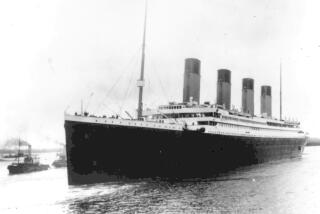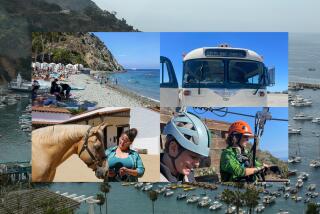Diving for the Past : Archeologist Is Chronicling a History of Shipwrecks Off the Channel Islands
Scuba diving off the coast of Santa Rosa Island one day, Don Morris came across an archeological puzzle: the scattered remains of a ship.
As the Channel Islands National Park archeologist, Morris had spent years researching shipwrecks around the islands off the Ventura County coast. But he had no record of a ship sinking at that spot.
Then a volunteer came across a paragraph in an obscure 1931 Coast Guard document: “received word by radio that the W.T. & B No. 60, a motor barge, was on fire and abandoned. . . . Derelict was sighted and towed to East Point, Santa Rosa Island, where derelict was demolished.”
Logbooks from the Coast Guard cutter confirmed that the metal and wood Morris spotted were actually the remains of the Washington Tug & Barge Co. ship destroyed 63 years ago.
Morris added another shipwreck to his list.
That list--compiled from yellowed newspapers, ship logs, Coast Guard records and actual sightings of remains--now includes 79 wrecks within a mile of the five-island park. Another 25 ships sank within the park’s six-mile sanctuary.
Morris, working with a team of volunteers, has documented each of those wrecks in a 250-page report set for publication in December. Researchers, students, scuba divers and park rangers trying to protect wreck sites could all use the report one day.
But Morris has not finished his research.
“I’ve still got 50 wrecks to find,” said Morris, running his hand through his long graying hair. “I compare the archeologist to a trial attorney. If you just went with victims’ testimony, that gives you part of the story. But to get a fuller picture, you really need to go out and find the physical evidence.”
This is no treasure hunt. Any gold that sank with the ships has long since disappeared.
Rather, it is a scavenger hunt, searching for odd pieces of history that reveal how ships were built, why they wrecked, even how people lived.
*
There is the anchor from the three-masted schooner Comet buried in the sand on San Miguel Island. And the piece of plank painted pale blue, a clue to what the schooner Golden Horn looked like before it wrecked on Santa Rosa. And the brass fixtures of the Winfield Scott, the elegant side-wheel paddle boat that sunk near Anacapa Island.
“In terms of loss to history, the worst thing is when these vessels are scrapped,” Morris said. “They really do vanish. Wrecks in the water are really quite durable. An awful lot is preserved under water.”
*
Morris still remembers the memo he found in his files when he first took the Channel Islands job in 1985. The memo, written in the 1960s, asserted that there were no shipwrecks in the area. By 1985, the National Park Service had found only two.
Today, a map on Morris’ wall is covered with silver thumbtacks, each one indicating a wreck site he has surveyed. He scans the map, then adds another tack for a wreck he has just found on the south end of Santa Rosa.
The islands, sprinkled across the Santa Barbara Channel and often shrouded in fog, create a natural navigational hazard.
The oldest wreck found in the park’s waters is the Winfield Scott, a steamer laden with gold that sank in 1853. The most recent occurred this spring, when a boat pulled away from its moorings and rammed into the San Miguel coastline.
Most of the shipwreck searches begin in the library, scanning old newspapers and merchant vessel books for accounts of accidents.
This spring, researchers turned to the National Archives for further detail.
Bob Schwemmer, a volunteer from Valencia, traveled to San Francisco and Washington to tap archives there for more information on Channel Islands shipwrecks.
He returned with century-old wreck reports, filled out by hand.
The report on the schooner Golden Horn reports in neat script how the ship was “stranded in heavy fog” with 2,808 tons of coal. All 28 crew members survived.
“It’s fascinating research,” Schwemmer says, poring over the document. “They’re written during that period, the style of writing, the notes.”
Schwemmer’s interest in shipwrecks began when he started scuba diving around wreck sites. “Diving to a ship is a wonderful time capsule,” he says. “Time stopped when that ship went down.”
He soon began collecting books about merchant vessels, yachts and maritime trade. He heard about Morris’ project through the volunteer group, Channel Islands Marine Archeology Resources, and signed up to help.
One of his document searches solved a Channel Islands mystery, the legend of the Legend. Rumor had it that the sleek racing yacht, famous for winning the Transpac race from California to Hawaii, had sunk off the islands. There were even pictures of the wreck.
But no one had seen the remains or found any records of the accident. Schwemmer checked one registry for a pleasure craft called the Legend. When he found it, he checked another book for the owner’s name.
He called directory information, got the owner’s telephone number, and asked him about the Legend. The owner was able to confirm that the yacht had, indeed, gone down off San Miguel Island.
“The mystery of the research, it’s exciting,” Schwemmer says. “It’s that challenge to uncover somebody’s history.”
*
That history will be set down in the 250-page report Morris and his volunteers are compiling. Now in the editing stage, the report will appear in a series of National Park Service books with the uninspiring title, “Submerged Cultural Resources Assessment.”
Eventually, the Park Service hopes to create a more popular version of the book, which students, park visitors and scuba divers can use.
Morris admits his work this summer has been overshadowed by another archeological find: a rare fossilized skeleton of a pygmy mammoth on Santa Rosa Island. He was on the island, looking for shipwrecks, when two colleagues stumbled across the mammoth.
This week he will join an excavation team unearthing the fossil, believed to be the first full skeleton of the ancestral elephant ever found.
Like the mammoth bones, the shipwrecks reveal far more than the battered remnants left behind, he says.
“Take the Gold Rush era. Most people came to California by sea, not land,” Morris said. “By far the most accessible of these vessels, the easiest one to see, is the Winfield Scott. That’s the only place to see the best example of what’s left of the Gold Rush-era steamer.”
The wrecks also reveal clues to the region’s history.
For instance, six lumber schooners crashed around the Channel Islands, five of them headed for Los Angeles. The growing city needed the lumber to build the homes and offices that would make Los Angeles a population center. And there are innovations in shipbuilding. The Winfield Scott, built in 1850, was a paddle boat operating on steam. The Cuba, built in 1897, was by contrast a “perfectly modern ship” with a triple-expansion steam engine, Morris said.
Already, the Friends of the Channel Islands is offering diving trips to see these wrecks and giving lectures on them. Morris hopes his research will provide more opportunities for viewing the sites.
But the research could also draw new scavengers hunting for treasure in the ruined ships. For years, scuba divers have pocketed gold coins, picked up antique nails, even sawed off brass fixtures.
“I suppose we’re like the people who run Mount Vernon,” Morris said. “We want people to come. We want people to enjoy the history. But we don’t want people to walk away with the good silverware--or the bad silverware.”
More to Read
Sign up for Essential California
The most important California stories and recommendations in your inbox every morning.
You may occasionally receive promotional content from the Los Angeles Times.










